First World War Project
Herbert David GAMBELL M.M. (of Lynsted)
b. May 1897 Lance Corporal, Service Number 70855 |
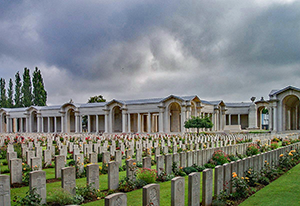
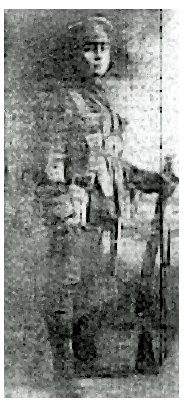 Herbert was born in Wychling in May 1897, son of David, a wagoner, and Mary Ann (née Burgess) and christened in Lynsted Church on 13 June the same year. He would later sing in Lynsted Church choir. There is some confusion in early records between Herbert's christening and the 1901 Census, in which he is registered as "Gambrell".
Herbert was born in Wychling in May 1897, son of David, a wagoner, and Mary Ann (née Burgess) and christened in Lynsted Church on 13 June the same year. He would later sing in Lynsted Church choir. There is some confusion in early records between Herbert's christening and the 1901 Census, in which he is registered as "Gambrell".
By the time of the 1901 Census, David and Mary were living at Ludgate Farm together with Herbert and his younger brother, Sydney Clarence William, and his Aunt Alice, the 12 year old sister of Mary. The 1911 Census places the family at Radfield Cottages, Bapchild, with the addition of another son, Wilfred John. On leaving school, Herbert took up employment as a farm labourer.
On 8 April 1915, Herbert attended his medical. On Monday 12 April, he was enlisted in The Buffs (East Kent Regiment) for the duration of the war. His attestation was witnessed by Frank Boucher, and the Magistrate, Colonel Honeyball. Herbert's recruitment papers show an annotation saying "this man is used to horses". This would prove useful for his work as a machine gunner.
At the time of his recruitment, Herbert claimed he was 19 years 11 months old. All records point to him being only 17 years 11 months old. This was not an unfamiliar occurrence. Although Herbert was only one month short of being eligible to enlist, the minimum age for service abroad was 19 years. With the benefit of hindsight we know what a young Herbert would have to face. However, in 1915 people did not have the dubious benefit of knowing the conditions they would face. The likelihood was that Herbert would have seen it as a chance to serve his country and something of an adventure.
After training in the 3rd (Reserve) Battalion, The Buffs (East Kent Regiment), Herbert was transferred to the 1st Battalion of the regiment, and posted to France on Tuesday 17 August 1915 as part of the British Expeditionary Force. He was underage by nine months.
At the beginning of the war, all infantry battalions had their own machine-gun section and the British Expeditionary Force established a Machine Gun School at Wisques in Frances. Herbert would serve in the 1st Battalion as part of their machine-gun crew.
Herbert joined his battalion at Poperinghe and within 2 days went into the trenches for the first time at La Brique. The remainder of 1915 and beginning of 1916 saw Herbert alternating between billets and long spells in the trenches.
On 16 March 1916, the 1st Battalion departed Flanders for Calais. Here they were given a much deserved 10 day "rest period". "Rest periods" were taken up with bringing the men up to speed on new methods of warfare and new inventions. It was also the only time for new drafts to train in mock trenches. So, at the end of this rest period, the men marched for 3 days to the Ypres area and back into the trenches at La Brique.
At the beginning of August, a month into the beginning of the Battle of the Somme, Herbert and the 1st Battalion, along with the rest of the 71st Brigade, moved to the trenches south of Beaumont Hamel. Then followed a period of intensive training during which they gradually approached the frontline.
Turning to Moody's "The Historical Record of The Buffs", he describes the action of the 1st Battalion on 15 September 1916. This was the first day of the Battle of Flers-Courcelette, when tanks were first used in action, sadly not successfully. During this action, Herbert distinguished himself and was awarded the Military Medal:
"One line of elaborate defence after another was falling into our hands, and Sir Douglas Haig determined to keep up the pressure as long as the weather and consequent state of the country permitted it. A general attack then was opened on the 15th September, the objective being the rearmost of the enemy's original lines of defence, between Morval and Le Sars; and when the advance on this front had gained the Morval line the Commander-in-Chief arranged to bring forward the left of the British troops across the Thiepval ridge.
There is a road running from Ginchy to Morval, and as it approaches the ridge, on which the latter village stands, it is sunken and of course conceals anything in it, and just half-way between the two villages a railway to the south of the sunken road almost touches it. Where the road and the railway most closely approach, the Germans had constructed a very strong work which was know as the Quadrilateral and which was but a little way from the edge of Bouteaux Wood. On the 13th of the month the 71st Brigade had attacked this Quadrilateral, but the attack had failed. The 15th was the first occasion on which tanks were used. Three of these new weapons were told off to assist at the attack of the Quadrilateral, and consequently a gap in our barrage had been arranged so that these could advance before the infantry started.
However successful the tanks were afterwards, these three proved worse than useless, because two of them broke down, and the third was so knocked about that it could do nothing, having amongst other injuries lost its periscope, so that it could not see. The unfortunate thing was, that there remained a gap in the barrage, exactly opposite the main face of the work to be assaulted. At 6.20am the 8th Bedfordshires advanced gallantly over the open, a bombing party attacking up a trench from the south-east. The enemy's machine guns caught the Bedfordshire men on the top of the ridge and, though they tried in the most manly way, they could make no progress.
The Buffs supported the Bedfords with the finest courage, but could not stand against the very heavy machine gun fire opposed to them. They suffered more casualties than any other unit in the brigade. A great number of men found cover in shell holes and managed later to get back into the lines. Captain Causton assembled as many of the battalion as he could in the trench originally occupied by the 8th Bedfords. The 2nd York and Lancaster Regiment had advanced behind the Buffs and had also assembled in the Bedfords' trench. On reorganising there were found in this trench about forty Buffs, two to three hundred York and Lancaster and forty Bedfords."
At this point, Herbert was one of the Buffs taking cover in a shell hole when 2nd Lieutenant Hills called for a volunteer to take a message back to the line. This would have to be done over open ground and under fire from the enemy machine guns and at risk from allied shells falling short. Herbert volunteered. This message was instrumental in alerting the Command that their Artillery were shelling British positions.
The History of the Buffs continues:
"About 12.30pm a number of the Battalion was still lying in shell holes in the open, and at that hour a message was received from 2nd Lieut Hills:
"Am in a series of shell holes about two hundred yards from the German line. German line was apparently untouched till midday bombardment. We got to the present position and were unable to proceed owing to machine guns. No signs of Bedfords ahead. Baly killed, Kesby and Miller wounded. Have about twelve men with me and can't get in touch with anybody. Our shells fell first right beyond German line, second just short, third very short. People in valley on left have just retired on account of shell fire. Machine guns are not touched, as all opened on retiring line. We have fire from the left and right and just off central sweeping us occasionally."
During the night of 15th/16th the Buffs were withdrawn to a trench running south-east of Guillemont after losing the following in casualties: Lieut. C J P Baly, 2nd Lieuts G W P Wyatt and G R Reid, and fifty-three men killed; 2nd Lieut Hill wounded; Captain T H Kesby and 2nd Lieut Miller and seven others wounded and missing; 2nd Lieut Smith, Captain Jones, RAMC, Lieut Tuke and 2nd Lieut Goodheart wounded. It was later ascertained that Kesby was amongst the slain. One hundred and eighty three other ranks wounded.
During the night the mass of wounded was cleared with the greatest energy. At 7 am on the 16th, strong German reinforcements were seen to enter the Quadrilateral."
The Buffs took no further part in the battle and were relieved on 19 September and marched 16 miles back to billets at Morlancourt. Here they expected a long rest, as the battalion was very tired and severely depleted. However, 24 hours later, they were marched back to the front to relieve a Guards brigade. Fighting continued until 25 September, with the Buffs being heavily involved in the fighting and wire-cutting. On 26 September, the battalion was again relieved by which time 174 of their comrades had been killed.
The battalion war diary entry for 13th October notes:
The following awards appeared in Divisional Orders:-
Capt. W.R. CORRALL – Military Cross
Lt. JACOBS – Military Cross
No. 6063 – Private Gamble [sic] H.D. – Military Medal.
| East Kent Gazette of 24th October 1918 |
WAR HONOUR The parishioners of Bapchild will be pleased to learn that Private H. D. Gambell, of The Buffs, who belongs to Bapchild, has been recommended for the Military Medal for bravery in the field. Private Gambell, who is 19 years of age, is the eldest son of Mr. and Mrs. D Gambell, of Radfield Cottages, Bapchild. He went to school in Bapchild, and afterwards worked on the farm at Radfield, and his employer, Mr. W. S. Wood, and the bailiff, Mr. G Philpott, speak in high terms of the lad. Before he was 18 he took charge of a team of four horses. Young Gambell joined The Buffs in April 1915, and went to France in August the same year. He came home on leave last January. The young soldier is now attached to a machine gun company, and his winning of the Military Medal at 19 is a feat to be proud of. The wish is general that young Gambell will be spared to return home after the War to enjoy his honours. |
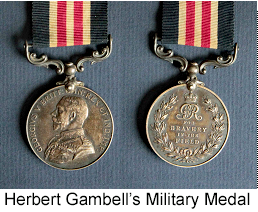 The awarding of the Military Medal [See Appendix 1] was confirmed in the London Gazette on 8 December 1916:
The awarding of the Military Medal [See Appendix 1] was confirmed in the London Gazette on 8 December 1916:
His Majesty the KING has been graciously pleased to award the Military Medal for bravery in the Field to the undermentioned Non-Commissioned Officers and Men: —
6063 Pte. H. D. Gambell, E. Kent R.
On 21 October, after a brief spell in the trenches near Givenchy, Herbert's battalion moved back to Daours and then to Bethune.
In October of 1915, a specialist "Machine Gun Corps" had been created. The machine gun teams that had been formed in each brigade were gradually transferred into the new Corps. Officers in the new Machine Gun Corps were required to be skilled in arms, mathematics, trigonometry and calculus. The fittest and best of the "other ranks" were chosen by the new Corps. This was not popular with some of the most senior officers, who would lose some of their most able men to this Corps. On Saturday 2 December 1916, Herbert was transferred to the 16th Company, Machine Gun Corps, remaining attached to 1st Buffs.
Four days later, on 6 December, Herbert was promoted to Lance Corporal (unpaid). He was now responsible for a crew of six men, and in charge of firing the gun and carrying and erecting the tripod.
There was no relief for Herbert until Christmas. The Company war diary tells us how Christmas day was celebrated:
| Date (1916) | Diary |
| 22nd Dec | All guns were relieved by 6p.m. The two PICCADILLY guns could not be retrieved until after dark. The whole of the Company went into billets at Beuvry. |
| 23rd | Sections cleaned up in the morning. The transport carried from LE QUESNOY to BETHUNE. |
| 24th | Sunday. The Company rested and had passes to BETHUNE. |
| 25th | The men were given an Xmas dinner by the Officers, waited on by the NCOs. Nothing was sent to the Company from England except 6 tins of Christmas pudding. (8th Tin). |
| 26th | Gun kit etc prepared for the trenches. Gas helmets inspected. |
| 27th | The Company relieved the 64th Machine Gun Company in the line HOHENZOLLEN SECTOR |
The beginning of 1917 opened with 6 weeks in the line at Vermelles. Eventually relieved on 15 February, when they marched to Bethune and then on to Robecq. On arrival at their billets, the officer in charge reported that no food was ready for the men and there was no cover for the horses. After 2 weeks of daily training, the Company marched back to Bethune then back into the line at Loos. The Company remained in the line for several weeks.
The war diary notes that, during April, work was being undertaken to repair damaged wire. It is therefore of no surprise that on 9 April 1917 Herbert injured his hand - "caused by galvanised wire". His injuries were initially treated by the 18 Field Ambulance, who then transferred him to the 1st Convalescent Hospital in Boulogne on 11 April.
The Medical Officer considered the injury to be "trivial", for which Herbert was deemed "not to blame". The Services were obviously on the lookout for self-inflicted wounds. Section 18 (2a) 33 of the Field Service Pocket Book (1914) states that "Wilfully maiming himself with intent to render himself unfit for service" has a maximum punishment of imprisonment.
On 29 April, Herbert returned to his base at Camiers and re-joined his Company in the field at Vermelles the following day.
The Company would soon move on to Philosophe and then to Mazingarbe, where they saw heavy fighting and little rest. As the Company moved to Hulloch on 1 July, Herbert left for a brief "home leave", no doubt buoyed up by hearing he had been awarded Proficiency Pay Class 1. He returned to his Company on 12 July.
On 25 July the Company was relieved and bussed to Bailleul Aux Cornailles, where they were no doubt relieved to have access to baths and new clothes. The next few days were used for a general clean-up in time for an inspection by the Brigadier General. Most of August was spent in training, with a brief break on 10 August for Brigade sports day; here they gained two firsts and a second.
By 29 August, they were back in the thick of it in trenches at Mazingarbe. For the next few months, the Company spent the majority of their time in trenches in the Cambrai area during which several men of the Company were awarded gallantry medals.
On Tuesday 4 December 1917, Herbert was made an Acting Second Corporal for a period of a week, and then, on 9 December, he was appointed "paid" Lance Corporal. The following day the Company was relieved and headed to billets in Courcelette Le Compte. Days in the approach to Christmas were taken up with training and gun drill. The Corp had a slightly delayed Christmas celebration, as the war diary details:
| Date (1917) | Diary |
| 24th Dec | Training |
| 25th Dec | Unable to give the men their Xmas dinner on this day owing to great difficulty of obtaining supplies. |
| 26th Dec | Training |
| 27th Dec | The Company treated this day as Xmas Day and the men had their Xmas dinners of Pork etc. Orders received from 16th Infantry Battalion that the Company must be ready to move to BOULON WOOD area at 3 hours notice. Guns and material were packed immediately. |
Herbert's Company continued with training until 26 January 1918, when they returned to the trenches.
On 23 February 1918, Herbert returned home for the last time. In his absence, on 1 March, the four Machine Gun Companies in the 6th Division, namely 16th, 18th, 71st and 192nd Companies, were amalgamated to form No.6 Battalion Machine Gun Corps.
On 9 March, Herbert returned to France and the following day joined his unit in the field. Here they were in position awaiting the expected attack at the start of the German Spring Offensive. The next 10 days were spent waiting for that battle to start.
At 2am on 21 March, a message was received from the Division that the enemy were expected to attack at dawn.
The following extract from the Battalion war diary details the actions of A Company, Herbert's Company on that day:
Action of "A" Company No.6 Battalion
Machine Gun Corps in the QUEANT SECTOR, March 21st and 22nd 19184.10 a.m.: Information received that the Enemy would probably attack during the morning and necessary preparations accordingly made.
5.0 a.m.: Intense hostile bombardment commenced by guns of all calibres, a large number of gas shells being used. The bombardment was particularly severe on front line and area behind the reserve line. All ranks wore box respirators during the bombardment. Telephone wires were cut and no communication was possible until the barrage lifted.
10.0 a.m.: Enemy reported over the top. From this time onwards, news was obtained from wounded men returning from LEEDS RESERVE where the enemy was held up by Strong Points for a considerable time.
Headquarters manned SUNKEN ROAD and later moved to DUNELM AVENUE joining infantry in manning the trench.
The enemy pressed on from both flanks and made good use of his light Machine Guns. Being unable to get into touch with any guns, the remaining party from Company H.Q. moved to the VAULX LINE, reaching same at 1.15 p.m.
Instructions were issued for all stragglers to be collected and the teams under 2/Lt ROBERTSON reinforced.
Headquarters then moved to Brigade at VAULX and scattered teams re-organised.No.1 SECTION
The guns of this Section fixed 8 belts on enemy advancing up the L'HIRONDELLE VALLEY, securing some good targets. Three guns were knocked out by hostile artillery, and the Officer in Charge wounded.
Owing to low visibility and enemy working around on left flank, the N.C.O. in charge withdrew his gun to a position in rear and later moved back to the VAULX-MORCHIES LINE.No.2 SECTION
The enemy was first observed about 2.0 p.m. on ridge between guns and NOREUIL VILLAGE. Fire was brought to bear on them by the two left guns and good results obtained.
The enemy was next observed coming up valley from LAGNICOURT and offered a splendid target. His advance was checked and heavy losses caused.
During the day, the enemy succeeded in gaining a footing in the trench to the left. The situation remained normal during the night and until about 8.0 a.m. on the morning of the 22nd, when the line was heavily bombarded.
At 10.0 a.m. the enemy obtained a footing in the trench to the right and the guns were mounted on parados and assisted our infantry in repeatedly expelling the enemy. Another gun was sent up, and did good work against enemy trying to enter VAULX WOOD.
At about 2.30 p.m. the infantry decided to evacuate the trench and their retirement was helped by the two remaining guns. After the infantry had retired the two guns moved back to SUNKEN ROAD at VAULX. One being hit by enemy shell on the way back and put out of action. Further orders were received to retire back to Army Line, and with two more guns collected from stragglers, positions were taken up, and held until relieved by the 41st M.G. Battalion at 2.30 a.m. on the 23rd inst.No.3 SECTION
No news is obtainable regarding three guns of this Section and it is assumed that the teams are casualties or prisoners. The Officer and Section Sergeant are also missing. The N.C.O. in charge of gun at C.11.c.83.57 reports that fire was opened on S.O.S1. Lines. When the mist lifted the enemy were observed advancing along road in C.11.b, in parties of thirty to fifty.
Fire was brought to bear on the road, heavy casualties inflicted and enemy stopped.
Owing to enemy working around to the back of gun position, the gun was withdrawn and later reinforced guns in rear. The two guns at C.17.d.00.70 were heavily shelled during the bombardment and it is thought that one gun and team was destroyed. The other gun fired 8 belts on S.O.S. line and 16 belts at enemy advancing across the open, causing heavy casualties. This gun was later put out of action and the two surviving men on team joined the guns in reserve.No.4 SECTION.
During the bombardment one gun was destroyed by shell fire, but no men were hit, although teams were standing by in readiness for action for six hours. When the barrage lifted, guns were ordered to fire on their S.O.S. [fn1] lines and continued to do so until the mist lifted, when the enemy were observed on ridge.
The battery being badly situated for direct fire, LIEUT EVES moved forward into LAGINOURT TRENCH and got into touch with the 2/Y&L who informed him that the 1/K.S.L.I. were holding the Sunken Road in front and that they were going to make a stand in their present position. The guns were mounted and, shortly afterwards, the enemy came on in force, great execution being done by the guns which continued firing until the enemy was within 40 yards.
Hostile parties however, gained a footing in the trench higher up and started working down, firing into the back of gun teams and putting one gun out of action with bombs.
The 2nd in Command, 1/K.S.L.I. now ordered all ranks in the vicinity to vacate trench as no bombs were available.
A dash across the open was made to DUNELM AVENUE, in doing so, the two men carrying guns were hit, and a number of spare men also became casualties.
Rifles were picked up and a stand made in DUNELM AVENUE, but the enemy bombed down the trench and drove the survivors into the open LIEUT EVES then made for the VAULX-MORCHIES line and attached his few remaining men to No.2 SECTION.OBSERVATIONS
The scheme of M.G. defence was entirely upset by enemy working around flanks. Most guns were sited for frontal fire and in order to traverse to the left and right, it was necessary to move positions, and in doing so many gun teams suffered casualties.Low visibility hampered gunners from obtaining good observation and, communication being impossible, many isolated teams were unaware of the situation until the enemy was at close quarters.
The system of shell hole emplacements without shell proof dug-outs and communication, does not improve the confidence of the teams, and their morale is shaken after a terrific bombardment of the nature experienced. Several guns were knocked out, which would have done good work had they been kept under shell proof cover and mounted directly the barrage lifted.
It is suggested that direct fire should in future be the first principle in M.G. defence schemes, and guns sited in pairs to form a series of strong points in echelon, the enemy will thus continually be held up.
The enemy employed large numbers of light machine guns, and appears to have made remarkable progress in the development of these arms.
(Signed) W.W. Hammond, Capt.
Commanding "A" Company. No.6 Battalion MGC. Dated 31st March 1918.fn1: An "S.O.S." barrage was fired in response to a German counterattack. An S.O.S. barrage could be requested via a flare signal of a pre arranged colour if the telephone lines had been cut. A pre-arranged barrage would then be aimed at No Man's Land.
The casualty figures for the No 6 Battalion Machine Gun Corps for 21/22 March 1918 numbered:
| Officer | Other Ranks | |
| Killed | 3 |
11 |
| Wounded | 6 |
76 |
| Missing | 5 |
194 |
TOTAL |
14 |
281 |
Of the 64 machine guns in the Corps, 60 were lost or destroyed.
Winston Churchill, then British Minister of Munitions, was at the front on that day. He wrote:
"there was a rumble of artillery fire, mostly distant, and the thudding explosions of aeroplane raids. And then, exactly as a pianist runs his hands across a keyboard from treble to bass, there rose in less than one minute the most tremendous cannonade I shall ever hear. It swept around us in a wide curve of red flame".
In all, casualties on 21/22 March 1918, totalled:
| Killed | Wounded | Prisoners | Total | |
| German | 10,851 | 28,778 | 300 | 39,929 |
| British | 7,512 | 10,000 | 31,000 | 38,512 |
Herbert had survived 2½ years of intense fighting as a machine-gunner at a time when their average life expectancy was 3 weeks.
Herbert's death was announced:
| East Kent Gazette of 27th April 1918 |
ROLL OF HONOUR Mr. and Mrs. David Gambell, of Radfield, Bapchild, Sittingbourne, have received the sad news of the death of their elder son, Herbert David Gambell, who was a lance-corporal in the Buffs, and who was killed in action on 21st March, the first day of the German offensive. The young man who was in his 21st year, and whose portrait is given, was employed on the farm at Radfield, when he joined the Army in April 1915. He went to France the following August, and in September 1916 won the Military Medal for taking an urgent message, in action, near Guillemont, under fire. A notice of the young soldier's gallant feat appeared in the "Gazette" at the time. He had been in France for two and a half years, and only returned home on leave on March 10th. An officer, in writing to Mrs. Gambell, informing her of her son's death, says:- "He was one of the best men we had. He was killed during an action on 21st March. I regret that I was not his own officer, but I have heard of him from his officer, who was badly wounded on the same day. I may say that everyone who knew him spoke very highly of him, and every one in the Company regrets his loss. I ask you to accept my deepest sympathy, and indeed the sympathy of the other officers and men of the Company." Writing on April 18th, Sec-Lieut. N. E. Dalby, officer in charge of No 1 Section, said:- "Dear Madam, It grieves me very much to reply to your letter with reference to your boy. There are only a few words that can explain the circumstances leading up to the end. He had charge of one of my guns when the Boche attacked us on the 21st. The only possible thing which any of the gunners could do was to stick to duty. This he did bravely, but very shortly afterwards was hit by a bullet from a rifle or machine gun, of the Boche, through the chest. The result was instantaneous death so he did not suffer and (as is usually the case when hit) probably did not feel it at all. He was, indeed, a splendid fellow; one of the best of my boys, and liked by all (officers and men), a most agreeable fellow. The place where he was hit was beside a ruined village called Noreuil, which is near a more important place called Lagnicourt. The nearest large town would be Bullecourt. Of course you know that the Boche has all that ground now, so we cannot say exactly where he is buried. But the Boche is not quite so bad as he is painted; so I am sure he will have a soldier's grave." Mr. and Mrs. Gambell have a younger son fighting in France, and it is hoped that he will come through safely. Much sympathy is felt for the bereaved family. |
Herbert's family placed the following notice:
| East Kent Gazette of 27th April 1918 |
GAMBELL – In loving Memory of our beloved son, who gave his life for his country on March 21st 1918, in his 21st year. Could we have clasped his dying hand, For he died for his king and country, From Mum, Dad, and Brothers. |
A further announcement was made:
| Faversham and North East Kent News of 11th May 1918 |
ROLL OF HONOUR The death is reported of another former member of the Lynsted Church Choir namely Corpl. Herbert David Gambell, M.M., of the Machine Gun Corps, who was killed in action on the opening day of the present German offensive. His parents formerly lived at Ludgate Farm, Lynsted, but some years ago moved into the adjoining parish of Bapchild. |
Herbert did not live to be officially presented with his Military Medal. Neither were his parents, who were by now living in Wanstalls Cottage, Greenstreet, able to accept the invitation to attend a presentation in London. Herbert was posthumously awarded the 1914-15 Star, British War and Victory medals. [See Appendix 1]
In November 1918, Herbert's father received his money owing, in the amount of £13 7s 6d (£13.37½p). In May 1920, he also received the War Gratuity of £14. [See Appendix 2] Taken together these amount to roughly £1,500 in today's money.
| Herbert has no known grave but is commemorated on the Arras Memorial, Pas de Calais, France, Bay 10. (See top of page) | 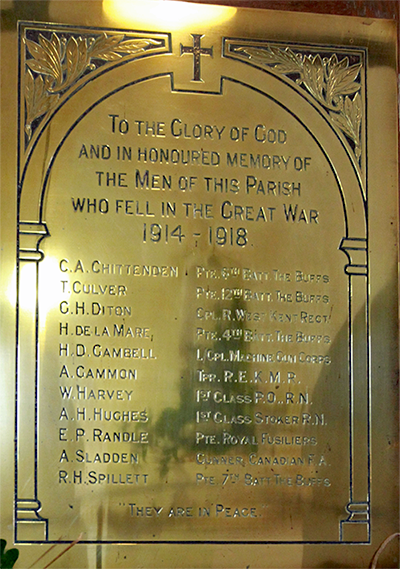 |
| He is also remembered on the Bapchild Memorial, in the Church of St Laurence. |
On the formation of the Machine Gun Corps, Belton House near Grantham in Lincolnshire was handed over to the forces and a machine gun school set up in the grounds. The nearby parish church of St Wulfram became the regimental church of the Corps. A plaque has been erected on the north wall, commemorating the 160,500 men of the Machine Gun Corps. Below the plaque lies the Roll of Honour for the 62,000 men of the Corps who gave their lives in World War One. The high number of casualties gave rise to the Corp's nickname of "The Suicide Club".
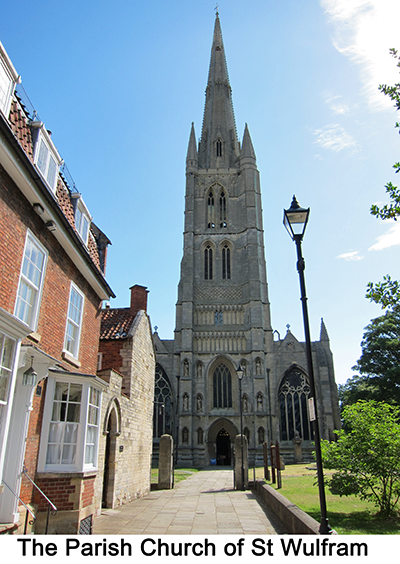 |
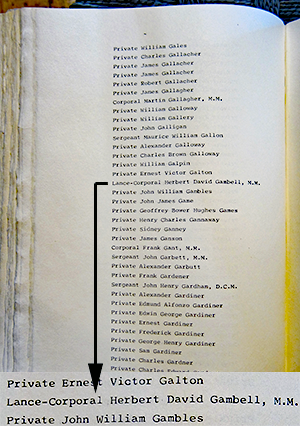 |
Herbert's younger brother, Sydney, also enlisted in the forces underage. However, he was found out and returned home twice. He eventually did join the Royal West Kent Regiment when of age and also served in the Machine Gun Corps. Sydney survived the conflict. Herbert's youngest brother, Wilfred, died in 1919 while serving in the forces. He is also commemorated by Lynsted with Kingsdown Society.
On the first anniversary of his death, Herbert's parents remembered their son:
| East Kent Gazette of 22nd March 1919 |
IN MEMORIAM GAMBELL. In ever-loving memory of our dearest son and brother, Lance-Corporal Herbert David Gambell, M.M., eldest son of Mr. and Mrs. D. Gambell, Radfield, Bapchild, who fell in action, March 21st, 1918.
|

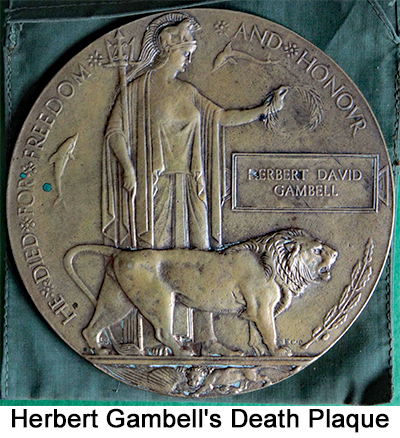
 World War 1 Pages
World War 1 Pages